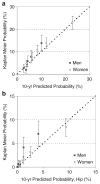Fracture prediction and calibration of a Canadian FRAX® tool: a population-based report from CaMos
- PMID: 21161508
- PMCID: PMC5101064
- DOI: 10.1007/s00198-010-1465-1
Fracture prediction and calibration of a Canadian FRAX® tool: a population-based report from CaMos
Abstract
A new Canadian WHO fracture risk assessment (FRAX®) tool to predict 10-year fracture probability was compared with observed 10-year fracture outcomes in a large Canadian population-based study (CaMos). The Canadian FRAX tool showed good calibration and discrimination for both hip and major osteoporotic fractures.
Introduction: The purpose of this study was to validate a new Canadian WHO fracture risk assessment (FRAX®) tool in a prospective, population-based cohort, the Canadian Multicentre Osteoporosis Study (CaMos).
Methods: A FRAX tool calibrated to the Canadian population was developed by the WHO Collaborating Centre for Metabolic Bone Diseases using national hip fracture and mortality data. Ten-year FRAX probabilities with and without bone mineral density (BMD) were derived for CaMos women (N = 4,778) and men (N = 1,919) and compared with observed fracture outcomes to 10 years (Kaplan-Meier method). Cox proportional hazard models were used to investigate the contribution of individual FRAX variables.
Results: Mean overall 10-year FRAX probability with BMD for major osteoporotic fractures was not significantly different from the observed value in men [predicted 5.4% vs. observed 6.4% (95%CI 5.2-7.5%)] and only slightly lower in women [predicted 10.8% vs. observed 12.0% (95%CI 11.0-12.9%)]. FRAX was well calibrated for hip fracture assessment in women [predicted 2.7% vs. observed 2.7% (95%CI 2.2-3.2%)] but underestimated risk in men [predicted 1.3% vs. observed 2.4% (95%CI 1.7-3.1%)]. FRAX with BMD showed better fracture discrimination than FRAX without BMD or BMD alone. Age, body mass index, prior fragility fracture and femoral neck BMD were significant independent predictors of major osteoporotic fractures; sex, age, prior fragility fracture and femoral neck BMD were significant independent predictors of hip fractures.
Conclusion: The Canadian FRAX tool provides predictions consistent with observed fracture rates in Canadian women and men, thereby providing a valuable tool for Canadian clinicians assessing patients at risk of fracture.
Conflict of interest statement
None.
Figures


References
-
- Berger C, Goltzman D, Langsetmo L, Joseph L, Kreiger N, Tenenhouse A, Davison KS, Josse R, Prior J, Hanley D CaMos Research Group. Peak bone mass from longitudinal data: implications for the prevalence, pathophysiology, and diagnosis of osteoporosis. J Bone Miner Res. 2010;25:1948–1957. - PMC - PubMed
-
- Melton LJ., III Epidemiology worldwide. Endocrinol Metab Clin North Am. 2003;32(1):1–13. v. - PubMed
-
- Johnell O, Kanis JA. An estimate of the worldwide prevalence and disability associated with osteoporotic fractures. Osteoporos Int. 2006;17(12):1726–1733. - PubMed
Publication types
MeSH terms
Grants and funding
LinkOut - more resources
Full Text Sources
Medical

